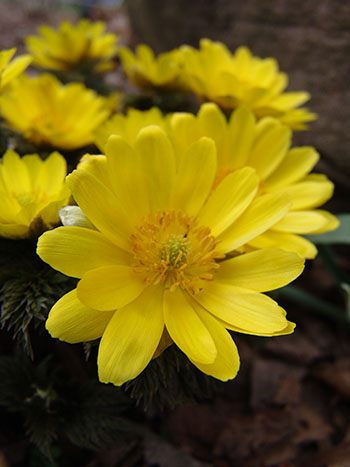Plants of the Week: March 16
Adonis amurensis
Winter is slowly but surely loosening its grip on the area allowing some of the very early plants to begin peeking through the hard soil. Seeing the beginnings of Adonis, after a long winter, feels like encountering a piece of gold lying in the garden. It is nice to remember that colors can be this vibrant. As a member of the buttercup family, A. amurensis offers a bright array of gold petals and stamens above feathery, dissected foliage (not present quite yet) and blooms from a complex, tubular calyx structure. As the days get a little warmer, this spring ephemeral will grow to about 10 inches and produce blooms until going completely dormant in June. photo credit: R. Robert
Zanthoxylum simulans
This is certainly the time of year to notice unique bark characteristics! This is a tree that does not like close contact. The entire trunk boasts a particularly stand-offish display of 2”-3” conical thorns that resemble enormous rose thorns. It is especially interesting to note the layering of bark tissue that accumulates along the slope of the thorns; almost resembling an insect abdomen. The pericarps of the seeds are finely ground and used in Chinese cuisine. photo credit: J. Bickel
![Hamamelis x intermedia 'Primavera' JTB [3]](https://www.scottarboretum.org/wp-content/uploads/2015/03/Hamamelis-x-intermedia-Primavera-JTB-3.jpg) Hamamelis x intermedia ‘Primavera’
Hamamelis x intermedia ‘Primavera’
One never really tires of viewing precocious witchhazels after a long winter; they serve as a fine apéritif to stimulate one’s appetite for spring colors. Aside from being a beautiful specimen, and seemingly unsusceptible to the marcescence exhibited by some Hamamelis, ‘Primavera’ boasts a later bloom time, producing sweet, fragrant, dense clusters of bright yellow flowers in February and March; as well as attractive fall foliage. photo credit: J. Bickel






![Zanthoxylum simulans JTB [3]](https://www.scottarboretum.org/wp-content/uploads/2015/03/Zanthoxylum-simulans-JTB-3.jpg)
susan betts
Posted at 20:09h, 18 MarchI also enjoy winter aconites for their gold. I believe they have fewer flower petals than the adonis. I saw a good display of the aconites recently at Morris Arboretum when I was on a
“witchhazel tour.” It was fun and interesting to see so many varieties and to learn some of their history. Sue Betts